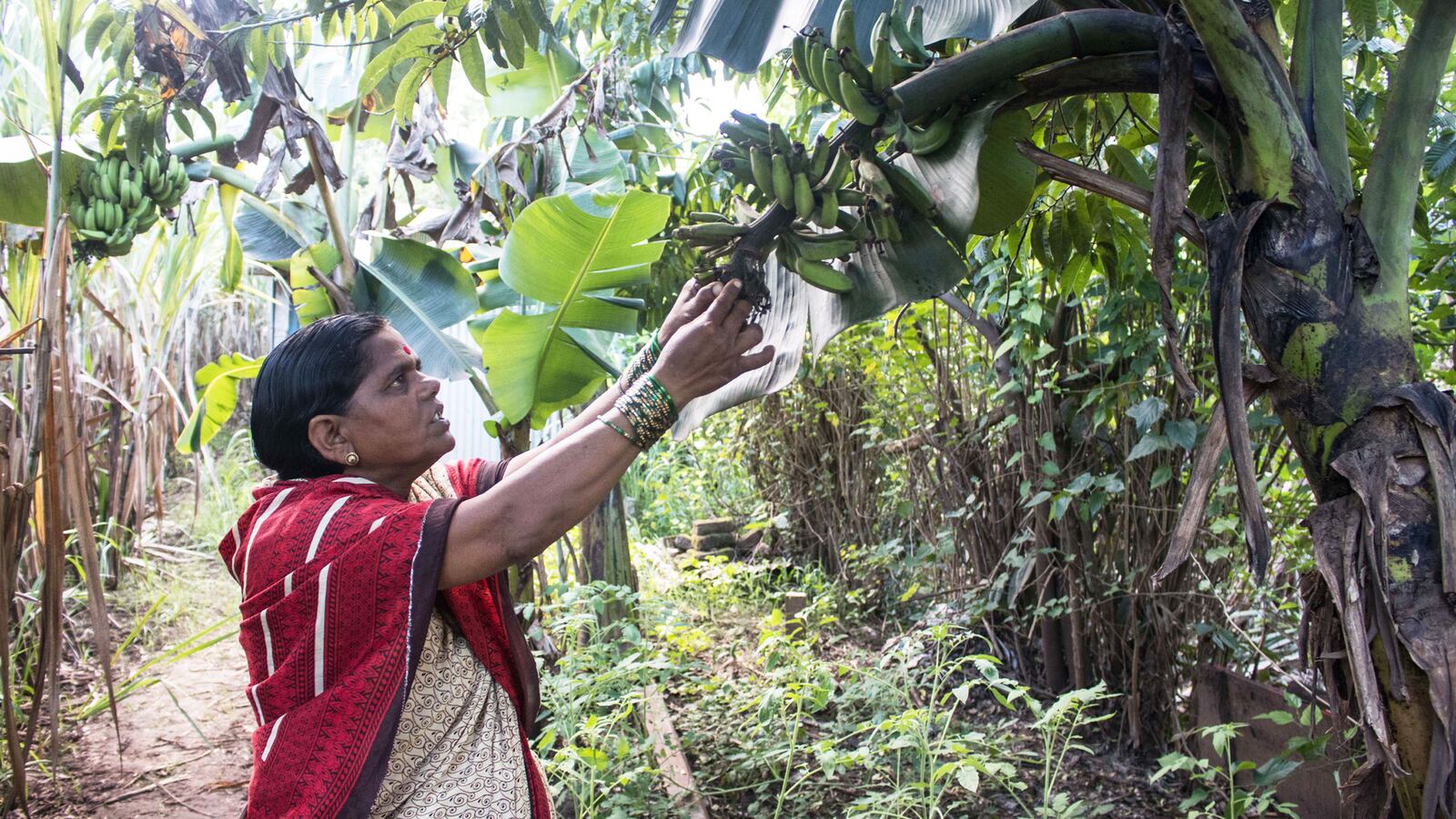Every month, Chhaya Patil visits a doctor to hear the same advice. “Don’t overstress.”
After her twentieth visit since floods in Western India ravaged her mud house in August 2019, she had enough. Be it joint pain, dizziness, headache, or breathlessness, Patil now buys a few painkillers and rests for two hours before resuming her 16-hour workday as a farmworker. She knows this is a warning signaling something serious but as she lamented to The Daily Beast, “Who will I talk to, and what should I say? This is what a woman’s life is reduced to.”
Patil, who is in her mid-fifties, never faced these health ailments until the floods, which she called “mentally devastating.” Within just two days, the floodwater engulfed her village of Arjunwad in the Kolhapur district of India’s Maharashtra state. Her home was destroyed. The government gave her a compensation of just $720 after three months. “How can someone build a house in that amount?” she said. “I had to take a loan of $2,650.”
Another flood partially destroyed the house 23 months later, leaving her homeless for 45 days. “This time, the water was at least 12 feet high,” she recalled. The financial pain has been even worse. “I’ve missed three loan repayments from July 2021, and now the amount keeps compounding.”
Patil’s repayment is a monthly installment of $14. To raise this money, she would have to work 10 days straight of back-breaking labor. Her husband, Balaso, passed away two decades ago after a heart attack, and her daughter is married, leaving her alone—further compounding the anxiety.
In the age of climate change, Patil’s story is increasingly common. The rise of recurring flooding events around the world put farmers at the forefront of danger. The UN Office For Disaster Risk Reduction issued a report last year that showed 3,254 flood events on record from 2000–2019, up from 1,389 during 1980–1999. In 20 years, flooding events have killed 104,614 people and impacted 1.65 billion others, leading to a loss of $651 billion worldwide. The World Bank estimates that 1.47 billion people in the world now live in areas at risk for intense flooding. About 600 million of them live in poverty.
But women farmers are especially vulnerable to climate change. Women make up nearly 75 percent of the full-time farming force in India, and are responsible for 60-80 percent of the country’s food production. Those numbers track with the rest of the developing world as well. As floods continue to rush in with greater frequency and force, it is women who must adapt and make the hardest sacrifices to keep their families afloat.

Lata Chandure lost over 44,000 pounds of sugar cane on her farm due floods. Her home was destroyed twice in three years.
Sanket JainHow Did We Get Here?
“What we are seeing is a basic property of response to climate change, especially over the monsoon regions,” said Roxy Mathew Koll, a climate scientist at the Indian Institute of Tropical Meteorology (IITM) and a contributor to the UN’s Intergovernmental Panel on Climate Change (IPCC).
According to the latest IPCC report, since 1850 greenhouse gases have warmed the planet by 1.1 degrees Celsius. This is projected to go past 1.5 degrees degrees Celsius in the next two decades. Beyond 2 degrees Celsius of warming, the world is expected to face sea level rises, increased storm events, and intolerable weather that could render some places outright unlivable.
But even now, the impact is being felt by vulnerable communities. Koll has observed monsoon patterns changing accordingly, moving into longer dry periods with intermittent short spells of heavy rains. That’s because warmer temperatures allow the air to saturate with moisture for longer periods of time. Then when it rains, all that excess moisture is dumped in a very short period—just a few days or sometimes a few hours. This is exacerbated by the formation of cyclones that are already bringing in more rains anyway, to India and other parts of the world as well.
All this results in a periodic thumping by storms that inevitably leads to frequent flash floods, at a rate that people have never dealt with before. There is hardly any time to rebuild homes and restore farm land to its previous status before the next flooding event rolls in.

A flood evacuation operation taking place in Maharashtra’s Ghalwad village.
Sanket JainThe Impact on Women
In Maharashtra itself, floods between June and October of this year destroyed over 13.59 million acres of crops. That included the half-acre of land owned by Lata Chandure, a marginal farmer in Maharashtra’s Ghalwad village. Dangerous floods have destroyed her home twice in three years, and she’s lost over 44,000 pounds of sugar cane. Her husband, who works as a mason, found just four days of work after July floods pushed the family into a debt of $2,350.
So her 12-year-old daughter Gauri had to learn to stitch masks during the pandemic. She earns less than a dollar for stitching 100 double-layered masks and has thus far stitched over 1,200 masks. “It takes around eight hours to stitch 50 masks, leaving me with lots of back pain,” Gauri told The Daily Beast.
Her mother, who’s in her mid-50s, never wanted her daughter to bear the brunt of the climate crisis. “It happened all of a sudden,” Chandure said.
Medha Kale, a Maharashtra-based activist for women’s health for over two decades, said this kind of story is increasingly all too common. “After a disaster, everyone assumes that it’s just the woman’s responsibility to restart life from rebuilding the house to feeding the family. It leads to an increase in anxiety, depression, and a rise in the stress levels,” she told The Daily Beast. Without access to treatment and support, these women are unable to work at full capacity, leading to a further erosion in their quality of life.
Research shows that the financial pressures and food insecurity created by climate change-related disasters have led to a rise in child marriages and gender-based violence in many parts of the developing world.
Chandure now suffers from insomnia and her vision is failing due to cataracts. Her doctors say surgery to remedy her eyes could cost roughly $200. “It’s unaffordable, but I don’t know for how long I can delay it,” she said.

Lata Chandure’s 12-year-old daughter, Gauri, had to learn to stitch masks during the pandemic to help her family make ends meet after floods devastated their sugar cane.
Sanket JainIt Takes a Village
In the short term, Kale suggests a series of local policy changes that mandate farming practices meant to prevent soil erosion; farm loan waivers given to flood victims to free them from incurring debt; and better compensation for lost property and crops.
Kale also suggests building a robust network that provides mental and social support to flood victims, especially with the world more cognizant of mental health issues these days.
“Post every disaster,” said Kale. “It’s important to identify and reduce stress, build a support system for people with suicidal thoughts by arranging mental health camps, house to house visits, and deploy at least barefoot counselors to identify the signs and symptoms of mental illnesses.” Social networks during times of crisis, she said, can help alleviate stress and anxiety and build solidarity amongst women, not just to face the disaster but battle other concurrent issues like rampant alcoholism and domestic and sexual violence.
It’s also essential that young girls and women are taught simple survival skills that can pay off in times of floods. Only a handful of rural women know how to swim, said Kale. “Women are never taught important life skills like swimming, climbing a tree—but every boy is taught this. Several women have lost lives because of the lack of life skills.”
Radical Change
Some changes, however, require a bigger rethinking in human activities across different industries. Increased demand for sand and gravel over the last 20 years has led to a huge bloom in sand mining in rivers—much of which is unregulated and unsustainable. An underrated consequence of sand mining is the erosion of river bed, allowing excess water to flood areas downstream. A 2019 UN report warned that, “Aggregate extraction in rivers has led to pollution, flooding, lowering of water aquifers and worsening drought occurrence,” and recommended better enforcement of laws and regulations against both legal and illegal sand mining.
Koll suggests building small canals or openings that can divert floodwaters, which requires conserving open spaces and flood plains. “In coastal regions, mangroves are a good option for absorbing additional floodwater,” he said. “It could be wetlands or swampy lands in other regions that should be preserved for the additional water to sink in.”

Rupali Koli from the village Arjunwad in India’s Maharashtra state had to sell her two goats and seek a private loan to raise money for everyday essentials.
Sanket JainYet the Indian government has been totally unresponsive to calls to rein in the sand mining, nor has it taken much action to build diverting waterways for floodwaters. It has deployed Band-Aid solutions like building elevated roadways. Vijay Pawar, the editor of Mahankarya, a regional newspaper based in Kolhapur, told The Daily Beast that while this might keep the roads safe, it ends up creating less movement for water, and he’s seen floodwater spread out and pummel through surrounding villages as a result.
And in some cases, it’s too late to really save the land. Some rivers have irreversibly lost their flood plains. Rupali Koli, 35, a widow tenant farmer from the same village as Patil, has witnessed this firsthand thanks to unplanned and illegal construction on the floodplains of the nearby Krishna River. Excess water no longer gets transported downstream, and ensuing floods have wiped out her crops. “This never happened in the past two floods,” she said.
A few countries have been able to find solutions to protect communities from recurring floods. In the Netherlands, instead of increasing the height of the levees or damming the Maas River, Dutch engineers and hydrologists gave more space for the rivers to swell by creating a 1,300-acre floodplain. Under a $2.7 billion project called Room for the River, the Dutch have built 30 catchment areas around the Maas and Rhine rivers that act as virtual floodplains storing excess waters and averting floods.
But projects like this take a lot of money, and a robust amount of willpower. And ultimately, none of these solutions will outright stop the root cause of flooding events: climate change. India will continue to face an average of 17 flooding events each year—and probably more if global temperatures continue to rise and human development continues to wreck natural systems that mitigate floods.

Hundreds of villages in Western Maharashtra in India were ravaged by two floods in three years.
Sanket JainMeanwhile, women farmers like Patil, Chandure, and Koli—essential to much of the world’s food production—continue to drown both in constant fear of floods and mounting debt like millions of women worldwide. The solutions to protect them so they can continue to help feed the world are there; yet it’s entirely unclear whether they’ll find help in time.
“The climate has become unpredictable, and so have our lives,” said Patil.


